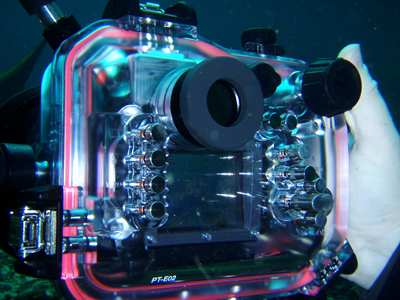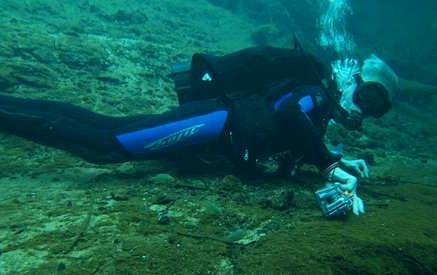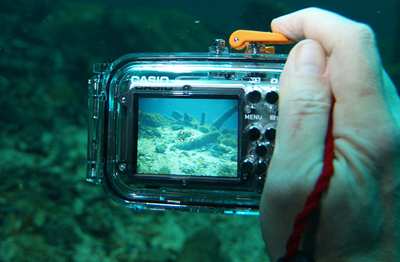« More diving, finally! | Main | Don't eat me! »
March 8, 2007
More on taking pictures underwater
When I had a chance last Fall to do underwater photography with a variety of different cameras, my final conclusion had been, "I wish I could go back and try again, applying what I learned." That's because the results had been mixed. There seemed a very large difference between the pictures I managed to take and the terrific underwater photography one sees in books, magazines and on websites. Now I know, of course, that whatever gets printed or displayed is always the best of the best, the one picture in a hundred, or even a thousand, that stands out. So I always need to remind myself that the people who took those great pictures also take a whole bunch of crappy ones and then they weed those out, just as I do.
Still, taking pictures underwater had been a rather humbling experience. I never fancied myself a great photographer by any means, but I am the co-founder of Digital Camera Magazine, the first magazine that exclusively covered digital photography and imaging. That seems no big deal now, but back in 1998 everyone thought we were crazy, that digital cameras were just toys, and that film would never go away or even be challenged. Well, we know how that turned out.
Anyway, in my position of running Digital Camera I've reviewed hundreds of cameras and taken tens of thousands of pictures, so I am not a novice either. But when I got into scuba and then began reviewing cameras that can shoot underwater I quickly found that taking pictures beneath the surface is different, and I wish I'd been better prepared. Which isn't easy. In my office I have hundreds of photography books. They get sent to us for review in the magazine and our photography websites. I have dozens on Photoshop and all the other imaging programs, and there are books covering every conceivable aspect of photography: landscapes, people, weddings, sports, fashion, marketing, equipment, and so on. But not a single one on underwater photography. Maybe that's just not a big enough market. But if it isn't, then why do almost all of the big camera manufacturers offer underwater housings? Still, in all my trips to Borders and Barnes & Noble book stores I have yet to find a single book on underwater photography. And believe me, those are more needed than yet another one on how to shoot models or weddings.
Anyway, I did get my wish of going back to those same places (and a few new ones), with four new cameras to test. I was determined to avoid the mistakes I had made last Fall and I was determined to return with some good shots. But most of all I as determined to get a real "feel" for how to take pictures underwater. Well, I did get to spend hours underwater and I took at least one camera with me on every dive. Was I successful? Did I do much better? Yes and no. I came back with better pictures, but what I learned, primarily, was what to do and what not to do.
See, shooting pictures above water is pretty simple. Know your camera, pick a scene, then wait for the perfect shot. Underwater it's completely different. By now I am no longer a total neebie diver and I am no longer afraid of what may await me once I go down, but it's still far from a normal environment for me. Being underwater with all that scuba gear, moving in a foreign medium, forever having to watch depth and air pressure and track all the other information on my dive computer, that's very different from standing in a field with a camera. Then there's the mask on your face, the bubbles you're blowing with every breath, and the ever-present awareness that job number one is not making some dumb mistake that could cost you your life. And, oh, let's take some pictures.
But I did learn, and here are some of the things I learned:
Picking the right camera to take with on a dive is even more important than to pick the right one above water. If you think taking along a single lens reflex camera with an external flash is a pain on a road trip, it's ten times as bad when you go diving. Underwater cases even for fairly compact dSLRs such as the Olympus Evolt E-330 are large and bulky. The external flash has its own acryllic housing. Then you need a bunch of brackets and mounting hardware and cables, and put it all together. The result is big. And heavy. And not neutrally buoyant. I quickly found that diving with a digital SLR with external flash and underwater housing is not easy at all. As a relative novice I still use my hands and arms to compensate, hold on to things and right myself. That'd be the same two arms and hands needed to hold a big SLR underwater. I hate to admit it, but at times I simply hung the whole rig over my arm, hoped that it wouldn't fall off, and used my hands to balance and swim.
That said, having a real single lens reflex camera down there opened a whole new world of picture taking. The external flash alone adds a new dimension. You really can't use an onboard flash underwater for anything but macro photography. Anything else will simply illuminate whatever debris and particles float in the water. With an external flash it all works. The farther away the flash is from the lens, the better, hence the big bracket that separates the camera from the flash by a good distance.
Those used to underwater photography with a single lens reflex would love the "live view" LCD screen on the Evolt. SLR viewfinders are terrific because they show you exactly what the lens sees, but having to peek through one underwater quickly becomes a pain. The Evolt's bright, large LCD showed what the lens sees without having to use the optical viewfinder, and that came in very handy.
 However, having a big powerful camera like the Olympus Evolt exascerbates another problem I've encountered with underwater photography: that of really needing to know the camera inside out to get the best possible pictures. It's really vexing; figuring out all those buttons and levers and menus is challenging enough above the surface, but there you can often leave the camera in its automatic setting and the picturs come out just fine. Underwater, where the camera needs to work a lot harder and where using the proper settings can make all the difference, you're not only in a foreign environment with time limits and a mask on your face, but the camera is also inside this big case and it's even harder to figure out all the buttons, even if you have a reasonably good command of the camera's functions. I spent a lot of time with the manuals and thought I knew all the major functions, but once the Evolt was in its case, I decided to just set the flash to its most automatic mode (TTL auto) and the camera to its underwater setting. That worked reasonably well, but in no way exhausted all the capabilities and power of this camera.
However, having a big powerful camera like the Olympus Evolt exascerbates another problem I've encountered with underwater photography: that of really needing to know the camera inside out to get the best possible pictures. It's really vexing; figuring out all those buttons and levers and menus is challenging enough above the surface, but there you can often leave the camera in its automatic setting and the picturs come out just fine. Underwater, where the camera needs to work a lot harder and where using the proper settings can make all the difference, you're not only in a foreign environment with time limits and a mask on your face, but the camera is also inside this big case and it's even harder to figure out all the buttons, even if you have a reasonably good command of the camera's functions. I spent a lot of time with the manuals and thought I knew all the major functions, but once the Evolt was in its case, I decided to just set the flash to its most automatic mode (TTL auto) and the camera to its underwater setting. That worked reasonably well, but in no way exhausted all the capabilities and power of this camera.
The other extreme is to take a camera along that is so small and unobtrusive that it doesn't interfere with your diving at all. Scuba divers have had this option for years. There are inexpensive one-use film cameras that work amazingly well, and there are very compact dedicated underwater cameras, and also very compact cases for a large number of those sleek new digital cameras. However, as of now nothing I know of can beat the Olympus Stylus 770 SW, a camera that doesn't need a housing at all for a lot of dives. Its 33-foot depth rating is conservative as it works just fine at 40 to 45 feet, and even takes pictures at almost 70 feet. It never flooded even when the water pressure at 67 feet pushed in some of its mechanical buttons so that they would no longer operate reliably. The freedom this little camera provided was just terrific. Simply take it along on a dive and then shoot pictures. Or not.

Another problem I encountered was being able to read the markings and icons underwater. Things are actually magnified underwater due to the optical properties of wearing a mask, but making out those tiny icons and letters can still be a challenge. So I often found myself fiddling with settings and such when I should have used those precious minutes underwater just looking around, learning, experiencing and enjoying myself.
 When I took a new camera on a dive for the first time, a Casio EX-Z750 in its dedcated deepwater case, I again found myself frustrated over not having spent enough time learning the camera and thinking things through. The Casio's case had a flash diffuser meant to minimize the dreaded "back scatter," but it didn't help very much. Even in its underwater mode, the camera insisted on setting off the flash for almost every shot, with rather mediocre results. I tried to turn the flash off just to find I couldn't. I ended up taking mostly macro shots, which turned out great, but it showed me again the one cardinal rule of underwater photography: Know your camera by heart, inside and out!
When I took a new camera on a dive for the first time, a Casio EX-Z750 in its dedcated deepwater case, I again found myself frustrated over not having spent enough time learning the camera and thinking things through. The Casio's case had a flash diffuser meant to minimize the dreaded "back scatter," but it didn't help very much. Even in its underwater mode, the camera insisted on setting off the flash for almost every shot, with rather mediocre results. I tried to turn the flash off just to find I couldn't. I ended up taking mostly macro shots, which turned out great, but it showed me again the one cardinal rule of underwater photography: Know your camera by heart, inside and out!
I hope that one of these days I, too, will be able to take wonderful, glorious shots of exotic sea creatures, reefs, and all the cool stuff I see in accomplished underwater photographers' galleries and websites. For now I am learning what equipment to take with me on a dive, how to prepare for it, how to handle it while I am underwater, and just generally how to take baby steps.
Posted by conradb212 at March 8, 2007 11:10 PM








